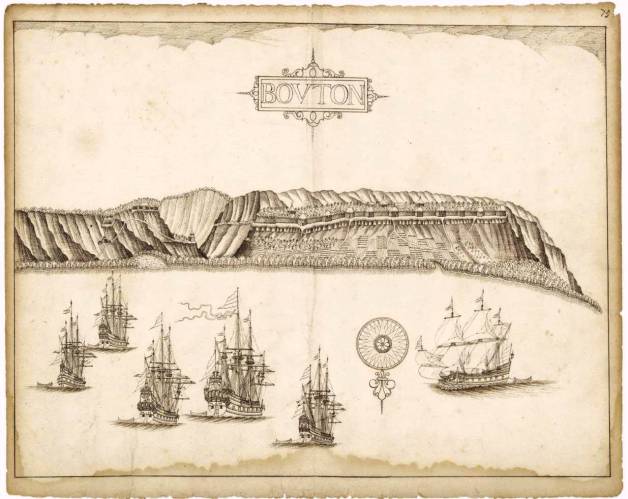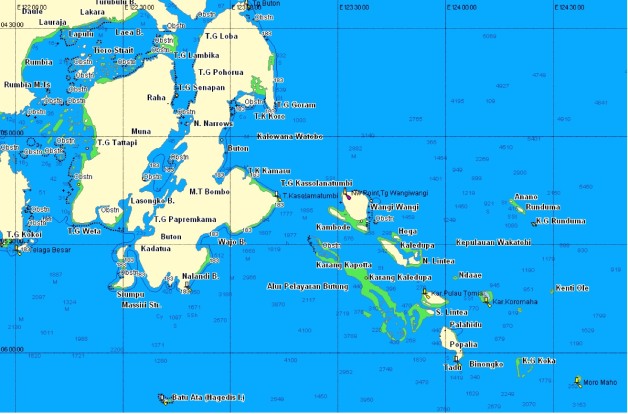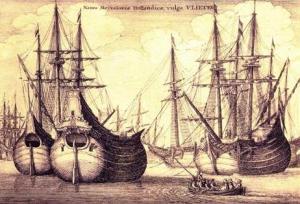A fluyt of 200t, lost during a voyage from Banda to Batavia, reportedly ‘lost off a reef, south off Buton’ with a cargo of spices.
The DR for 1643, on pgs.84 and 115, offers us two complementary versions of the affair. Closing in to the Tukang Besi Islands, the ship ‘met with a reef that extends well 3 or 4 miles into the open sea, onto which three anchors were dropped but the cables broke and the ship was beaten to pieces so that [the crew] hardly found time to rescue their lives’. The Otter‘s company, though, managed to take to the boats; yet, ‘after having been two days in sea from the ship, the pilot Philip and those of his boat [?] didn’t want to go further to Makassar, but to Batavia, took leave from the boat [the eventual lone survivor was in] and each sailed their own way’. I could not locate any further reports on the fate of the pilot and his company.
After five days the survivors reached ‘Pangasana’, today’s island of Muna, where they in a village called Selanca (or, Chalancka) intended to look for water. The local population ‘in the beginning treated them well and lodged [them] in a house but at night raided the said house and killed all the people, except for 5 who could flee [… yet] were followed and also killed’, leaving alive only our reporter, a certain Abraham Thomassen of Amsterdam. The Otter‘s captain, Hans Jacobsen, apparently made a stand, and though he ‘had received a gash in the breast, wounded the chief of the land with a knife’; Thomassen, however, by then ‘had jumped out of the dance’, to spend the coming three months [!] ‘hidden in the bush’. Forced by hunger he finally returned to the village, where he found ‘of the people still alive a women with two small daughters, a Maardijker [here, possibly, an Indo-Portugues] with a slave and a female slave with a child, who a little later were taken to Makassar as serfs’.
Here our two versions start to diverge: The report written on May 25, 1644, relates that Thomassen ‘for 30 suits of cloth was sold to the king’ of Buton, where he was picked up by ships from Batavia ‘and brought back to order, thanking God for his live’; the second version, seemingly noted in December 1643 but only in 1644 received in Batavia, tells us that the villagers on Muna at some moment ‘for fear of the Makassarese who had asked [their chief] to come thither to court, with two vessels and around 400 people, be they men or women, fled to Buton’, where he arrived ’24 days’ before the arrival of Dutch ships.

Dutch ships in the roads of Bau-Bau, Buton, ca. 1650
The VOC computed her loss to be fl.64,590.3.8; yet, as ‘this year by the foundering of the Otter only a small quantity of Bandanese spices [nutmeg and mace, the singular produce of the Banda islands] could be send [to the Netherlands] and now not much of the demand be supplied, the fruits should, cost-wise, go better off the hands and the warehouses would be emptied’ – if then necessary, more spices will be sent on request (for such an opinion and policy cf. the arguments ensuing the foundering of the Schellag, a good hundred years later …).
The respective letter, dated December 23, 1644 (GM for 1639-1655, pg.237) also knows that ‘the prince of Makassar, Karaeng Pattingaloang, did his best to get the murderers by their heads’, but that the latter had fled to Buton. The Makassarese could recover only ‘a silver bowl coming from the Otter and 124 1/4 reals in cash’; handing these over to the VOC representative in Makassar was judged to be a deed ‘rather rare for a moor’.
It is up to the reader to locate the reef on which the Otter had probably foundered … .



